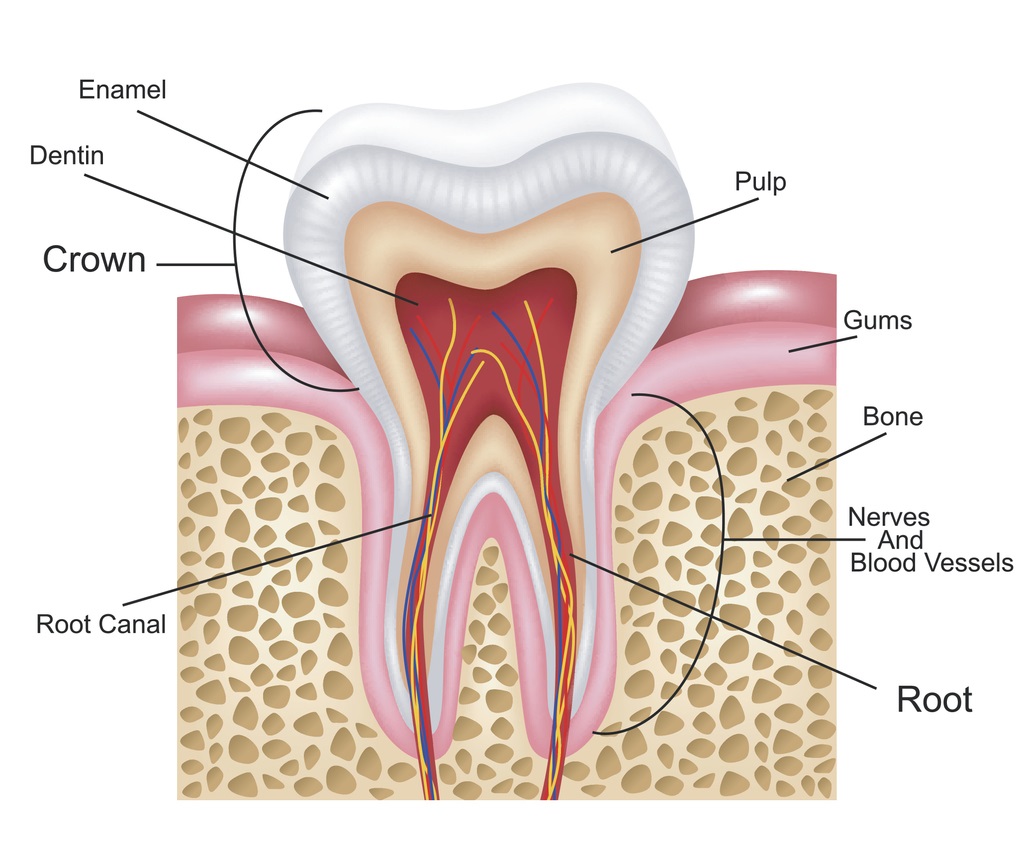What is root canal?
A root canal is a dental procedure used to save a tooth that has become deeply decayed or infected. During root canal treatment, your dentist or endodontist will remove the damaged pulp from inside of the decaying tooth and follow by cleaning and sealing the canal(s) to protect against future infection Your dentist can then place a crown or filling to protect your tooth and restore it to full function.
Human Tooth Anatomy
Root canal treatment
Your dentist may recommend a root canal treatment if you have been experiencing severe tooth pain, and the pulp or nerve of your tooth is infected or inflamed. This inflammation can be caused by either dental decay, a cracked or broken tooth, or tooth injury.
Any infected pulp must be removed; otherwise, bacteria will begin to multiply within the pulp chamber, which could lead to an abscess. If an abscess forms, then your tooth may not be salvageable, and you may require an extraction. However, root canal treatments have proven to be highly successful in repairing damaged teeth, with a success rate of 86 to 98%.1 Most patients will not require follow-up treatment, and after a filling or crown their newly restored tooth can last them a lifetime.
FAQ on root canal
If your dentist recommends a root canal, it’s natural to feel a little nervous. But rest assured, this procedure is relatively painless and extremely effective in preserving the integrity of your tooth. Here are some answers to frequently asked questions.
Some signs that may indicate you need a root canal include:
- Severe and persistent tooth pain
- Prolonged sensitivity to hot or cold temperatures
- Swelling and tenderness in nearby gums
- Discoloration (graying) of the tooth
- Deep decay on a tooth
- The pulp is exposed after trauma to the tooth
- An abscess can be seen on an X-ray
Sometimes, there are no symptoms present.
Most dentists and endodontists choose to use local anesthesia and just numb the area around the tooth. This will typically remove any pain sensation. If you feel like you will need sedation, you should discuss it with the dental office providing the service to see if that is an option.
Before the procedure, your endodontist or dentist will administer local anesthetic (an injection, just like you would receive for a filling) to numb the area and prevent pain. They will then carefully remove the infected pulp inside the tooth, clean, disinfect, shape, and seal the root canal. Usually, this can be completed in one or two appointments, but more difficult cases may require an additional visit(s). After the root canal is completed a temporary filling is usually placed and an appointment is made with your dentist for a final filling or crown to restore the tooth to full function.
Before the procedure, your endodontist or dentist will administer local anesthetic (an injection, just like you would receive for a filling) to numb the area and prevent pain. They will then carefully remove the infected pulp inside the tooth, clean, disinfect, shape, and seal the root canal. Usually, this can be completed in one or two appointments, but more difficult cases may require an additional visit(s). After the root canal is completed a temporary filling is usually placed and an appointment is made with your dentist for a final filling or crown to restore the tooth to full function.
There is a greater understanding of pain management in dentistry today. With modern technology and anesthetics, the vast majority of people who undergo root canal treatment report minimal pain. You may experience tooth sensitivity for the first few days after the procedure, in which case, an over-the-counter pain reliever can help ease your discomfort. If your pain does not subside or becomes severe, it is important to contact your dental provider for further evaluation.
Patients receiving a root canal treatment can expect to undergo one or two appointments that last for about 90 minutes each. However, each case is different and will depend on the location and condition of the tooth, in addition to other factors. In general, front teeth will take less time due to easier access to the tooth and because they have fewer roots.
After receiving dental degrees, a small percentage of dentists go on to receive dental specialty degrees. While both dentists and endodontists can perform root canal treatments, endodontists limit their practice to treatments of the pulp. They do not do routine exams, cleanings, or fillings. Endodontists complete an additional 2 or 3 years of training after dental school and are considered highly trained specialists in pain management and pulpal therapies. Endodontists will typically have the specialized equipment and expertise to accomplish even difficult root canal procedures quickly, efficiently and with minimal discomfort. After completing a root canal treatment at the endodontist, they will typically refer you back to your general dentist to place the final filling or crown on the tooth.
The majority of individual dental insurance plans cover some percentage of root canal treatments. Costs will vary depending on your specific plan, the types of services required, and whether or not your endodontist is in-network. Use our cost estimator to learn more or check out this article about root canal cost.
1. Song M, Kim HC, Lee W, Kim E. Analysis of the cause of failure in nonsurgical endodontic treatment by microscopic inspection during endodontic microsurgery. J Endod. 2011;37:1516–9.
1. Song M, Kim HC, Lee W, Kim E. Analysis of the cause of failure in nonsurgical endodontic treatment by microscopic inspection during endodontic microsurgery. J Endod. 2011;37:1516–9.









